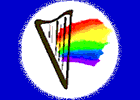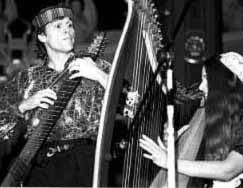














| Composing Contemporary Music for the Folk Harp With Other Instruments or Diatonics Can Be Fun (Abridged) by Teed Rockwell |
|
[Click here for unabridged version.]
What happens when you're a composer trained in jazz or rock, or
post-Renaissance , or Gershwin and Porter, and you fall in love with a
harper who plays an instrument that requires a mechanical change to make
every accidental? Do you cross off all those Beatles tunes, forget
about Ellington, and stick with Three Blind Mice? |
 Teed and Diana Stork of Geist |
If I had not loved the woman who was playing the harp even more than I loved the sound of the harp itself, I would never have voluntarily written any pieces that keep the same sharps or flats all the way through. But once I did write a few songs for the harp, I discovered that using jazz melodies and chords that did not modulate sounded more original than following the expected jazz changes. Those modulations which are the basis of modern popular music have become formulas which can hinder creativity if we forget that it is not always necessary to use them. One thing that opens up when you begin composing diatonically is a greater use of modes. We listeners of Western music are most familiar with two modes: the Ionian (go from C to C on the piano's white keys), which we call the major scale,, and the Aeolian (go from A to A), usually called the minor scale. Try the other ones, too, again on the white keys, or on the harp in the key of C: D to D - Dorian mode The three major modes, with the first and third notes constituting major thirds, are ionian, lydian, and mixolydian. The three minor modes are dorian, phrygian, and aeolian. locrian is the abandoned stepchild of the modes, with a minor third and a flatted, or diminished, fifth. If you spend enough time improvising and composing with each of these modes, you will eventually be able to recognize them after hearing only a couple of measures. Then the fun starts of passing from one mode to another, or playing chords from one mode against chords from another. The best way to contrast chords and modes is for the harp to play one, and another instrument to play the other, which can lead to the world of jazz chords, with notes piled on one another in intervals of sevenths, ninths, elevenths, and thirteenths! Any chord can also be voiced in a variety of ways by putting parts of it in different octaves, putting a note other than the root on the bottom, or leaving out certain notes. Or try having one instrument play the same note while chords are changing above it, or play the same melody twice with a different bass part each time. Each of the variations will change the personality of any given chord, and will open up new possibilities for you to try, giving your ear more choices to work with. Of course, if you're the harp player in a group, there are a few ways that you can modulate to some other keys:
In this day of information overload, when it is possible to study so many different kinds of music, the harp provides a kind of center for modern music to build around. When you concentrate on the keys available to the folk harp, your music becomes narrow and deep, rather than shallow and broad. It will no longer be possible to sound like everybody, but it will become easier to sound like yourself. And this, I feel, is at least part of what music needs to be great music. (The original [unabridged] article appeared in the Folk Harp Journal No. 52, March, 1986. |
|
Listen to Teed Rockwell, Diana Stork and Mika Scott play Indian Winter from the album More Light. ( You will need Realplayer to listen to this clip. ) |
||
| [To author biography] | [To full text] | [Back to top of page] |
Historical Harp | Folk and World Harp | Pedal Harp |
Harp Building | Harp Works | Non-Harps |
Camps & Concerts | Links | Glossary |
Donate! | Get Involved! | Contact Us | About Harp Spectrum
Copyright 2002 - 2017, Harp Spectrum All Rights Reserved